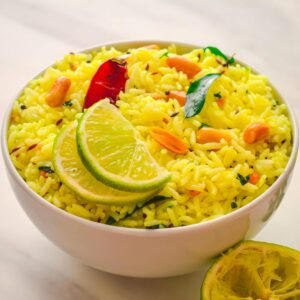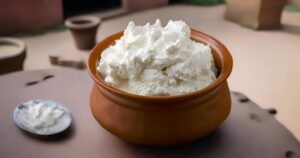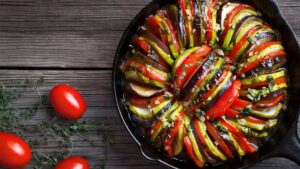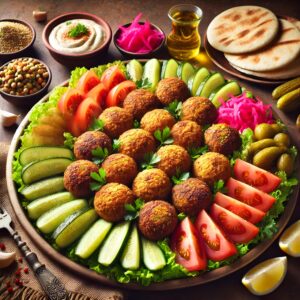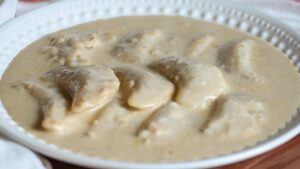Sabudana Khichdi Recipe
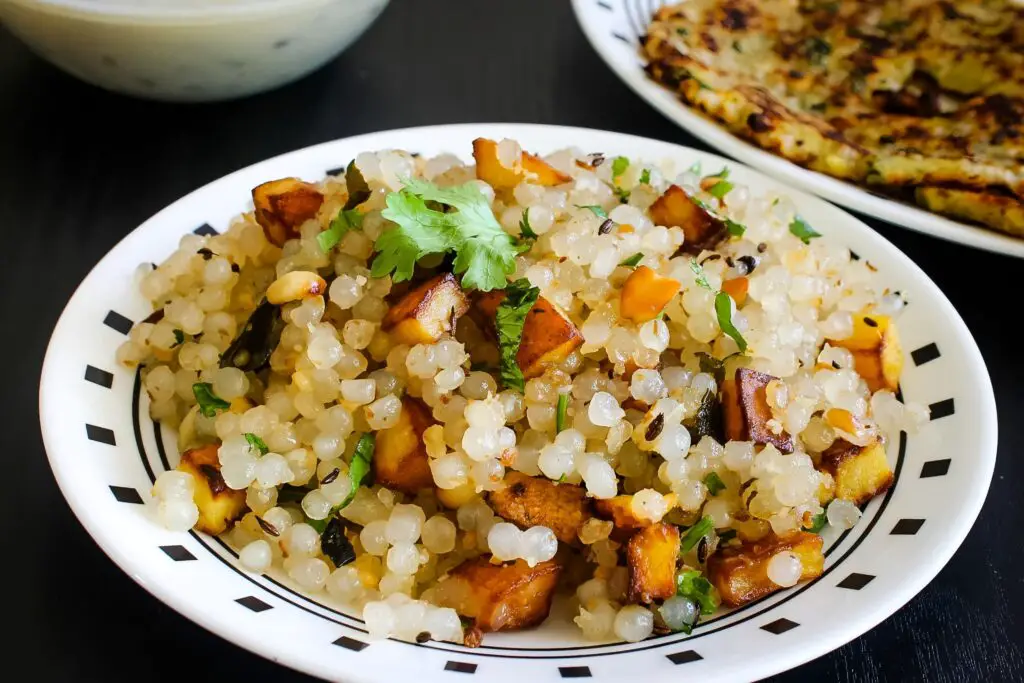
Introduction:
Sabudana Khichdi, a popular and much-loved Indian dish, is a delightful combination of soaked tapioca pearls (sabudana), peanuts, potatoes, and spices. It’s especially enjoyed during fasting periods like Navratri but is also a favorite breakfast or snack dish for many. This dish, known for its light yet satisfying texture, balances a blend of flavors and is quite nutritious. Below is an in-depth recipe and guide to making the perfect Sabudana Khichdi.
Ingredients
For Soaking:
- 1 cup Sabudana (Tapioca pearls)
- 1 cup Water (for soaking)
For Cooking:
- 2 medium-sized Potatoes (peeled and diced)
- 1/2 cup Roasted peanuts (coarsely ground)
- 2-3 Green chilies (finely chopped)
- 1 tsp Cumin seeds (Jeera)
- 8-10 Curry leaves
- 1/2 tsp Sugar (optional)
- 1 tsp Lemon juice
- 2 tbsp Ghee or oil (preferably peanut oil)
- Salt to taste
- Fresh Coriander leaves (Cilantro) for garnishing
Preparation
Soaking the Sabudana:
Selecting and Rinsing:
- Choose medium-sized sabudana pearls for best results. Before soaking, rinse the sabudana under running water in a sieve until the water runs clear. This step is crucial to remove excess starch and prevent the sabudana from becoming sticky when cooked.
Soaking Process:
- In a large bowl, add the rinsed sabudana. Pour in just enough water to cover the sabudana, ensuring it’s submerged but not excessively soaked. The ratio of sabudana to water should be about 1:1. Soak for 4-6 hours or overnight, depending on the type of sabudana. The pearls should become soft and plump but not mushy. You can test by pressing one between your fingers; it should be soft and easily mashable.
Draining:
- Once soaked, drain any excess water if needed. Let the sabudana sit in a sieve for 15-20 minutes to ensure it’s dry and non-sticky. This is vital for achieving a fluffy, non-clumpy khichdi.
- Cooking the Khichdi
Preparation of Ingredients:
Potatoes:
- Peel and dice the potatoes into small, even cubes. This ensures they cook evenly and quickly. You can parboil them to speed up the cooking process or sauté them directly in the khichdi.
Peanuts:
- Dry roast the peanuts in a pan until golden brown. Let them cool, then coarsely grind them. The peanuts add crunch and a rich, nutty flavor to the khichdi.
Cooking Steps:
Tempering:
- Heat a heavy-bottomed pan or kadhai over medium heat. Add 2 tablespoons of ghee or oil. Ghee is traditionally preferred for its rich flavor, but oil works well too.
- Once the ghee is hot, add 1 teaspoon of cumin seeds. Let them sizzle and turn golden brown, releasing their aroma.
- Add 8-10 curry leaves and the chopped green chilies. Sauté for a minute until the chilies are slightly blistered and the curry leaves are crisp.
Cooking the Potatoes:
- Add the diced potatoes to the pan. Sprinkle a little salt and sauté them until they are golden and cooked through. This step may take about 5-7 minutes. If the potatoes are parboiled, this will be quicker.
- Stir occasionally to ensure even cooking and prevent sticking.
Incorporating Sabudana:
- Reduce the heat to low and add the soaked sabudana to the pan. Stir gently to mix with the potatoes and tempering.
- Add the coarsely ground peanuts and a pinch of sugar if you prefer a slight sweetness. Sugar is optional but adds a nice contrast to the savory flavors.
- Mix everything gently to coat the sabudana with the peanut mixture evenly.
Cooking Sabudana:
- Cook the mixture on low heat, stirring occasionally, until the sabudana turns translucent. This should take about 5-7 minutes. Be careful not to overcook, as this can make the sabudana sticky.
- If the sabudana seems too dry or starts sticking, sprinkle a few drops of water. Stir gently to avoid breaking the pearls.
Final Touches:
- Once the sabudana is cooked, turn off the heat. Squeeze fresh lemon juice over the khichdi to add a tangy flavor.
- Garnish with chopped coriander leaves.
Serving Suggestions
Classic Style:
- Serve the Sabudana Khichdi hot, garnished with a few more roasted peanuts and a wedge of lemon on the side. The lemon enhances the flavors and balances the richness of the ghee and peanuts.
- With Yogurt:
- Sabudana Khichdi pairs beautifully with a bowl of plain yogurt (dahi). The coolness of the yogurt complements the warmth and spiciness of the khichdi.
Accompaniments:
- You can also serve the khichdi with some spicy mango pickle or coconut chutney for an added flavor dimension.
- Tips for the Perfect Sabudana Khichdi
Sabudana Quality:
- The quality of sabudana plays a crucial role in the outcome. Always use fresh, good-quality pearls. Avoid old stock as it may result in a sticky, mushy khichdi.
Soaking Time:
- Soaking time can vary based on the type of sabudana. Some varieties may need more or less time, so adjust accordingly. The goal is to have soft, non-sticky pearls that hold their shape when cooked.
Preventing Stickiness:
- To prevent the sabudana from clumping together, ensure it’s soaked correctly and drained well before cooking. Also, avoid stirring too much during cooking, as this can cause the pearls to break down and become mushy.
Peanut Balance:
- Adjust the amount of peanuts based on your preference. Some people like more peanuts for a nuttier flavor, while others prefer a lighter touch.
Variations:
- For added nutrition, you can include finely chopped vegetables like carrots or peas. However, this is less traditional and may alter the texture.
Spice Level:
- Adjust the number of green chilies based on your spice tolerance. If you prefer a milder khichdi, you can reduce the chilies or deseed them before chopping.
Nutritional Information
- Sabudana Khichdi is a balanced dish providing energy, protein, and essential nutrients. Sabudana is a rich source of carbohydrates, making this dish ideal for an energy boost, especially during fasting. The peanuts add protein and healthy fats, while the potatoes provide additional carbohydrates and dietary fiber.
Conclusion
- Sabudana Khichdi is not just a dish; it’s an experience that connects with the traditional and cultural roots of India. The simplicity of the ingredients, combined with the subtle yet rich flavors, makes it a go-to comfort food for many. Whether you’re observing a fast or simply looking for a delicious and satisfying meal, this khichdi is sure to delight your taste buds. With the detailed steps and tips provided, you can easily master the art of making Sabudana Khichdi, ensuring it turns out perfect every time.
FAQs for Sabudana Khichdi Recipe
-
Why does my Sabudana Khichdi turn out sticky?
Answer: The stickiness usually occurs due to over-soaking the sabudana or not draining the water properly. Ensure you soak the sabudana in a 1:1 ratio of water to pearls, and after soaking, drain them well. Cooking on low heat and avoiding excessive stirring also helps prevent stickiness.
-
How do I know if the sabudana is soaked properly?
Answer: Properly soaked sabudana will be soft, plump, and non-sticky. When you press a pearl between your fingers, it should easily mash without any hard center. The soaking time can vary, so check after 4-6 hours or overnight.
-
Can I use oil instead of ghee for this recipe?
Answer: Yes, you can use oil, particularly peanut or vegetable oil, which works well. However, ghee is traditionally preferred for its rich flavor and aroma, which enhances the overall taste of the khichdi.
-
Is it necessary to add sugar to Sabudana Khichdi?
Answer: No, sugar is optional. It’s added by some to balance the flavors with a slight sweetness. If you prefer a purely savory dish, you can skip the sugar.
-
How do I make the khichdi spicy?
Answer: To increase the spice level, add more green chilies or a pinch of red chili powder. You can also serve the khichdi with a spicy pickle or chutney on the side.
-
Can I prepare Sabudana Khichdi in advance?
Answer: Sabudana Khichdi is best enjoyed fresh as the sabudana can become hard or sticky when reheated. If you need to prepare it in advance, soak and prepare all the ingredients separately, then cook just before serving.
-
What other vegetables can I add to this recipe?
Answer: While the traditional recipe uses only potatoes, you can add finely chopped carrots, green peas, or even grated coconut for additional flavor and nutrition. Just ensure the vegetables are cooked until soft before adding the sabudana.
-
Is Sabudana Khichdi suitable for weight loss?
Answer: Sabudana is high in carbohydrates, which provides energy but can be calorie-dense. For a weight-loss-friendly version, use minimal ghee or oil, add more vegetables, and balance it with protein-rich sides like yogurt or cottage cheese.
-
Can I use raw peanuts instead of roasted ones?
Answer: Yes, you can use raw peanuts, but it’s best to dry roast them first for enhanced flavor and crunch. Roasting also helps in bringing out the nutty aroma that complements the khichdi well.
-
What can I serve with Sabudana Khichdi?
Answer: Sabudana Khichdi pairs well with plain yogurt, spicy chutneys, or even a simple cucumber raita. A wedge of lemon on the side adds a refreshing tang.
-
Is this dish gluten-free?
Answer: Yes, Sabudana Khichdi is naturally gluten-free, making it suitable for those with gluten sensitivities or celiac disease.
-
Can I freeze Sabudana Khichdi?
Answer: Freezing Sabudana Khichdi is not recommended as the texture of the sabudana may change upon thawing and reheating, leading to a sticky or hard texture. It’s best to prepare and consume it fresh.
-
How long can I store leftovers in the refrigerator?
Answer: Leftover Sabudana Khichdi can be stored in the refrigerator for up to 1-2 days. When reheating, sprinkle some water to prevent it from drying out and warm it gently on low heat.
-
What is the nutritional value of Sabudana Khichdi?
Answer: Sabudana Khichdi is high in carbohydrates, moderate in protein (due to peanuts), and contains healthy fats (from ghee or oil). It also provides dietary fiber from potatoes and peanuts, making it a good source of energy.
-
Can I use other types of oil for cooking Sabudana Khichdi?
Answer: Yes, you can use any neutral cooking oil like sunflower oil, canola oil, or coconut oil. Each type of oil will slightly alter the flavor of the dish, with coconut oil adding a more pronounced taste.


